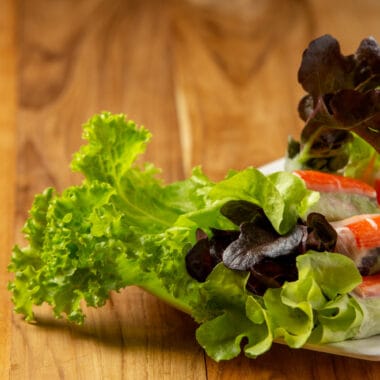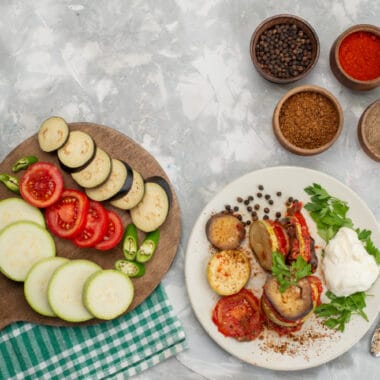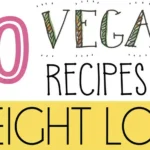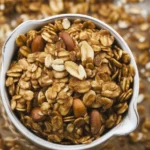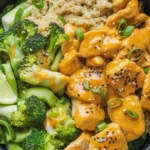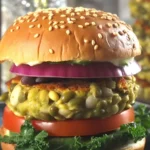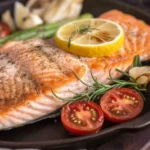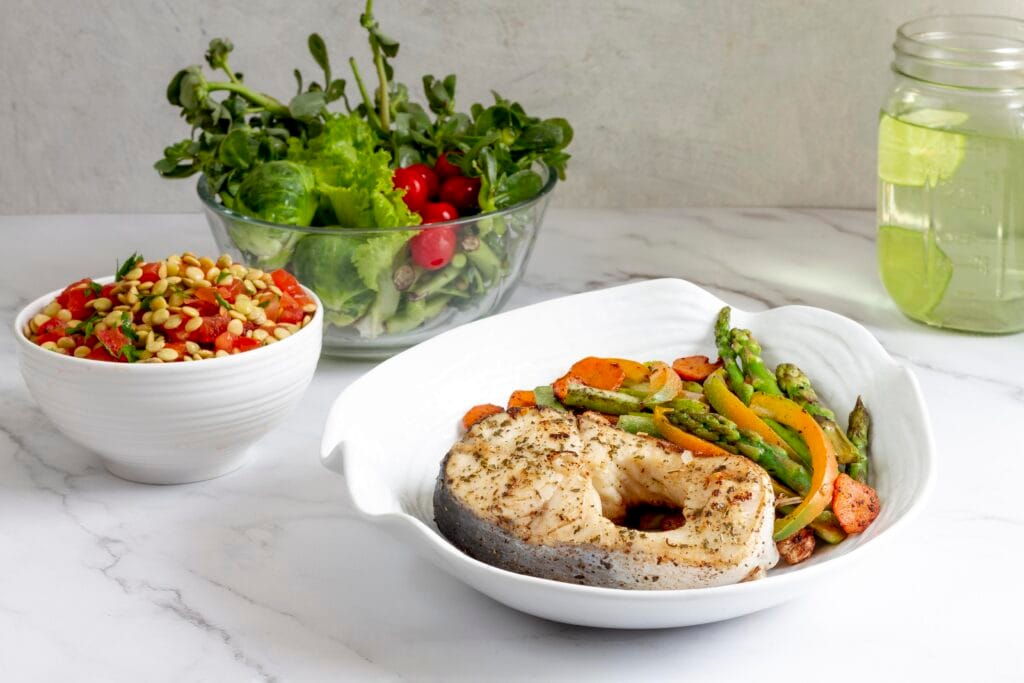
Imagine this: It’s 12:30 PM, and you’re staring at your office desk, stomach rumbling, craving something flavorful yet healthy. Instead of reaching for the same old boring sandwich or vending machine snack, you open your lunchbox to reveal a vibrant, colorful bowl filled with wholesome ingredients. It’s perfectly portioned, packed with nutrients, and—best of all—designed to support your weight loss goals. Welcome to the world of meal prep lunch bowls for weight loss—a game-changer for anyone looking to eat smarter, save time, and enjoy every bite.
In this comprehensive guide, we’ll explore everything you need to know about creating delicious, balanced lunch bowls that help you shed pounds without sacrificing flavor. We’ll share personal stories, expert insights, practical tips, and plenty of inspiration so you can confidently start your meal prep journey today.
Read Also: Why Lettuce Wraps Are the Ultimate Low Carb Lunch Solution
The Power of Meal Prep for Weight Loss
Meal prepping isn’t just a trend; it’s a proven strategy to improve your eating habits and support weight management. When you prepare your meals in advance, you’re more likely to control portion sizes, avoid impulsive choices, and incorporate a variety of nutrient-dense foods. According to nutrition experts, meal prep can save time, reduce stress, and foster healthier eating patterns—key ingredients for successful weight loss.
A study published in the Journal of Nutrition Education and Behavior found that individuals who meal prep regularly tend to consume fewer calories and more fruits and vegetables. Plus, having ready-to-eat meals means you’re less tempted by fast food or unhealthy snacks. For many, creating specific lunch bowls elevates this practice by making nutritious eating both enjoyable and visually appealing.
What Are Meal Prep Lunch Bowls?
Meal prep lunch bowls are versatile, single-serving dishes assembled with a base (like grains or greens), topped with proteins, healthy fats, vegetables, and flavorful sauces. The beauty of lunch bowls lies in their flexibility—think of them as edible masterpieces you can customize to suit your taste buds and nutritional needs.
These bowls are not only convenient but also highly adaptable. Whether you prefer a vegetarian chickpea and quinoa bowl or a chicken and sweet potato combo, they can be tailored to align with your weight loss goals, dietary preferences, and seasonal ingredients. Plus, they often use batch cooking, meaning you prepare multiple servings at once, making the week’s lunches a breeze.
Why Lunch Bowls Are Ideal for Weight Loss
Several factors make lunch bowls an excellent choice for weight-conscious eaters:
- Portion Control: With pre-measured ingredients or carefully divided servings, you naturally avoid overeating.
- Nutritional Balance: You can combine complex carbs, lean protein, healthy fats, and fiber-rich vegetables in every bowl, helping you stay full longer.
- Visual Satisfaction: Colorful, well-balanced bowls satisfy the eye as well as the palate, promoting mindful eating.
- Customizable & Sustainable: You can rotate ingredients and flavors, reducing boredom and maintaining motivation.
- Time & Cost-Efficient: Batch prepping saves time during busy weekdays and often cuts down on dining out expenses.
Research from the Harvard T.H. Chan School of Public Health emphasizes the importance of nutrient-dense, whole foods in weight management, which lunch bowls readily provide.
Building the Perfect Weight Loss Lunch Bowl
Creating a nutritious, satisfying lunch bowl starts with understanding its core components. Here’s a breakdown with tips, examples, and expert insights:
1. The Base: Whole Grains or Leafy Greens
Your bowl’s foundation determines its calorie content and nutrient profile. Opt for complex carbs or leafy greens:
- Whole grains: Quinoa, brown rice, farro, barley, or millet. These provide fiber, which aids digestion and promotes satiety. For example, quinoa packs complete protein and is gluten-free, making it an excellent choice for weight loss.
- Greens: Spinach, kale, arugula, or mixed greens. Use these for low-calorie, nutrient-dense bases that add volume without many calories.
According to the Dietary Guidelines for Americans, fiber-rich foods support weight management by reducing hunger and improving gut health.
2. Protein Power: Lean & Plant-Based Options
Protein is essential for muscle preservation and feeling full:
- Animal-based: Grilled chicken breast, turkey, shrimp, or lean beef.
- Plant-based: Chickpeas, lentils, tofu, tempeh, edamame, or hard-boiled eggs.
The American Heart Association emphasizes that incorporating lean protein sources helps control calorie intake and supports metabolic health.
3. Healthy Fats: Flavor & Satiety
Healthy fats enhance flavor and promote fullness:
- Avocado slices
- Nuts and seeds (almonds, chia, flaxseeds)
- Olive oil or tahini dressings
Research in the British Journal of Nutrition shows that healthy fats can aid in weight loss by improving satiety and stabilizing blood sugar levels.
4. Vegetables: The Colorful Crowd-Pleasers
Fill your bowls with a variety of vegetables:
- Roasted sweet potatoes
- Bell peppers
- Cherry tomatoes
- Broccoli
- Carrots
- Zucchini
Vegetables add fiber, vitamins, and antioxidants, which support overall health and weight loss.
5. Flavor & Dressings: Keep It Light & Fresh
Use herbs, spices, and light dressings to boost flavor without excess calories:
- Lemon juice, balsamic vinegar, or apple cider vinegar
- Fresh herbs like cilantro, parsley, or basil
- A drizzle of olive oil (in moderation)
Avoid heavy, creamy dressings that can turn your healthy bowl into a calorie bomb.
Meal Prep Strategies for Success
Preparing lunch bowls for the week can seem daunting at first, but with a few smart strategies, it becomes second nature:
- Batch Cooking Proteins & Grains: Cook large quantities of chicken, beans, or grains on Sundays.
- Pre-Chopping Vegetables: Store chopped vegetables in airtight containers for quick assembly.
- Use Mason Jars for Layering: Layer ingredients in jars to keep everything fresh and portable.
- Portion with Containers: Invest in quality meal prep containers that help with accurate portioning.
- Mix & Match: Keep a variety of ingredients on hand to create different bowls, preventing boredom.
The Meal Prep on Fleek website offers excellent tutorials and recipes tailored for weight loss-focused meal prep.
Sample Meal Prep Lunch Bowl Recipes for Weight Loss
Here are three tried-and-true recipes to inspire your weekly meal prep:
1. Mediterranean Chickpea & Quinoa Bowl
Ingredients:
- 1 cup cooked quinoa
- 1/2 cup roasted chickpeas
- Cherry tomatoes, halved
- Cucumber slices
- Feta cheese (optional)
- Fresh parsley
- Lemon-tahini dressing
Preparation:
Layer cooked quinoa at the bottom, top with chickpeas, vegetables, and feta. Drizzle with lemon-tahini dressing. Store in airtight containers for up to 4 days.
2. Grilled Chicken & Veggie Power Bowl
Ingredients:
- Grilled chicken breast, sliced
- Brown rice or farro
- Roasted sweet potatoes
- Steamed broccoli
- Avocado slices
- Olive oil and lemon juice for dressing
Preparation:
Assemble ingredients in bowls, drizzle with olive oil and lemon, and enjoy throughout the week.
3. Tofu & Veggie Stir-Fry Bowl
Ingredients:
- Cubed tofu, sautéed
- Quinoa or cauliflower rice
- Stir-fried bell peppers, zucchini, and carrots
- Sesame seeds
- Light soy or tamari sauce
Preparation:
Combine all ingredients, portion into containers, and refrigerate.
Nutritional Considerations & Expert Insights
While meal prep lunch bowls are inherently healthy, it’s crucial to balance macronutrients and avoid hidden calories. Consulting resources like the Harvard Health Publishing can help you understand portion sizes and nutrient density.
Moreover, incorporating mindful eating practices—such as eating slowly and savoring each bite—can enhance satisfaction and prevent overeating. The National Eating Disorders Association highlights that mindful eating supports weight management by fostering a better connection with hunger and fullness cues.
Comparing Popular Meal Prep Lunch Bowl Options
| Feature | Grain-Based Bowl | Green Bowl | Protein-Focused Bowl | Vegetarian/Vegan Bowl |
|---|---|---|---|---|
| Calorie Density | Moderate; depends on grains and toppings | Low; primarily greens and vegetables | Varies; depends on protein source | Low to moderate; plant proteins and veggies |
| Preparation Time | 30–45 minutes, batch cooking recommended | 15–20 minutes, quick assembly | 30–40 minutes with batch protein prep | 20–30 minutes, depends on ingredients |
| Nutritional Balance | Balanced carbs, fiber, protein, fats | Low-calorie, nutrient-dense | High protein, moderate carbs | Rich in fiber, antioxidants, plant protein |
| Suitability for Weight Loss | Excellent if portioned correctly | Excellent; very filling | Excellent; protein aids satiety | Excellent; high fiber and low calories |
Choosing the right bowl depends on personal preferences and dietary needs. For tailored guidance, consulting a registered dietitian can optimize your meal prep plan.
Frequently Asked Questions (FAQs)
Q1: How many calories should I aim for in each lunch bowl for weight loss?
A: While individual needs vary, most weight loss plans target around 300–500 calories per meal. Focus on nutrient-dense, filling ingredients to stay satisfied.
Q2: Can I meal prep lunch bowls for more than a week?
A: Generally, 3–4 days is optimal for freshness and safety. Freezing portions can extend shelf life, especially for protein components.
Q3: Are rice or grains necessary in all lunch bowls?
A: Not necessarily. Some bowls can be grain-free, using cauliflower rice or more greens for lower-calorie options.
Q4: How do I avoid boredom with meal prep bowls?
A: Rotate ingredients, try different dressings, and experiment with spices and herbs. Variety keeps meals exciting and sustainable.
Q5: What are some common pitfalls to avoid?
A: Overloading with high-calorie toppings, neglecting portion sizes, and relying on processed ingredients can derail your weight loss efforts.
Q6: What are some tips for maintaining motivation?
A: Keep your meals colorful and appealing, track your progress, and allow occasional treats to prevent feelings of deprivation.
Conclusion: Embrace the Joy of Nourishing, Weight-Loss-Friendly Lunch Bowls
Meal prep lunch bowls are more than just a practical solution—they’re an opportunity to reconnect with wholesome foods, unleash your creativity, and take control of your health journey. By combining colorful vegetables, lean proteins, whole grains, and flavorful dressings, you create meals that nourish your body and satisfy your taste buds.
Remember, consistency is key. Start small, experiment with recipes, and gradually build a repertoire of bowls that support your weight loss goals while bringing joy to your mealtime. As you become more comfortable with prep routines and ingredient combinations, you’ll find that healthy eating becomes second nature—no more last-minute scramble, no more guilt. Just delicious, satisfying lunches that propel you toward your best self.
If you’re eager to take the next step, consider setting aside a dedicated prep day each week, investing in quality containers, and exploring new flavors and cuisines. With time, patience, and a dash of creativity, your lunch bowls will become a highlight of your day—fueling your body, delighting your senses, and helping you achieve your weight loss aspirations.
